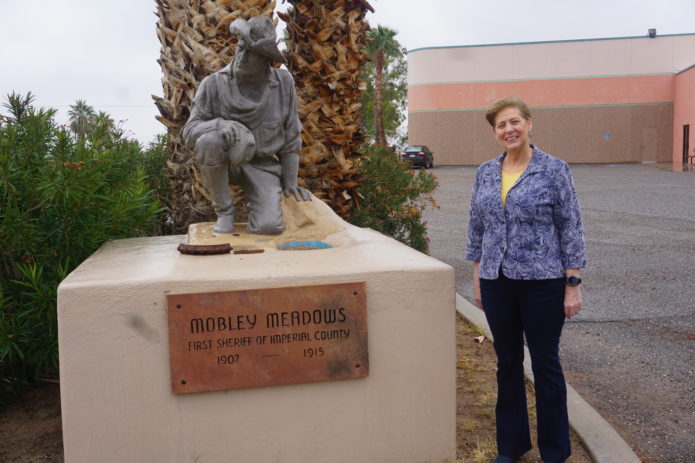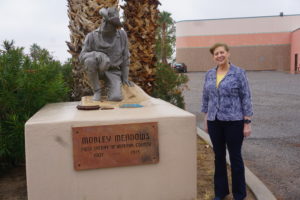
Lynn Housouer, chief executive officer of Pioneers Park Museum in the Imperial Valley, is photographed at the museum’s entrance next to a statue of Mobley Meadows, the first sheriff of Imperial County. Pioneers Museum is dedicated to preserving and showcasing the hundred-plus year history of Imperial County. On Feb. 2, the museum will hold its annual Pioneers’ Day, a free event featuring activities that teach about the region’s history and the pioneers who turned a harsh desert into a landscape where crops and a community could flourish.
The year was 1928—a mere 20 years after pioneers founded Imperial County and turned a barren desert on the southeastern tip of California into a region where lands could become fertile and farming could prosper.
With the passing of the Boulder Canyon Project Act that year, which would lead to the construction of the All-American Canal, even more growth would come to the young county.
Those early pioneers must have realized just how historic their efforts were in shaping the future of Imperial County because that year they formed the Imperial Valley Pioneers’ Association to preserve their history.
That early association and their small museum gave birth to what is today Pioneers Park Museum, a 22-acre park and museum at the corner of Highway 111 and Aten Road that showcases exhibits celebrating the pioneering spirit that turned this desert into a thriving agricultural center where green fields span some 400,000 acres.
“Those pioneers started thinking about preserving their history,” said Lynn Housouer, the museum’s chief executive officer. “They were making an effort to preserve their history for the benefit of future generations.”
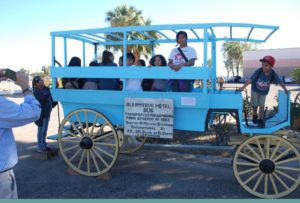
Young museum goers climb onto the old Imperial Hotel bus used to transport guests to and from train depot during the annual Pioneers’ Day event at the museum. This year’s Pioneers’ Day, which is free to the community, will be held Feb. 2 at the museum park on Highway 111 and Aten Road. Photo courtesy of Pioneers Museum
Pioneers Museum, which is managed by what is today the Imperial County Historical Society—the current incarnation of the original pioneers’ association—tells the history of the county through a massive collection of donated artifacts that weave a storyline of the earliest pioneers and how they survived such rugged conditions in hopes that their hard work would benefit their children and grandchildren. The museum also shares the multi-cultural foundation upon which the county was built.
The museum, which will hold its annual Pioneers Day event free for the community on Feb. 2, is a testament to the ongoing pioneering spirit in the Valley in that so many of its volunteers and members of the historical society are part of generational families who helped found the county.
Walk through the front doors of the museum and on the first floor off to the right is a complex filled with galleries celebrating the cultures and ethnic groups who were all a part of the county’s creation and remain part of the county today. In fact, it was each of those cultural groups who helped pay for the construction of that first floor.
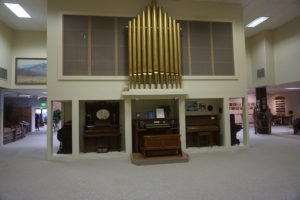
An historic pipe organ is on display inside Pioneers Museum. The organ is from 1904 and was used in an area church.
“The Imperial Valley as a whole came together to make this happen,” Housouer said.
It was in 1940 that the first museum was opened by the pioneers’ association at the Imperial Valley fairgrounds. That facility served an important role, allowing some of the pioneers’ artifacts to be displayed, but it was far from large enough to fully showcase the region’s history.
In 1992, thanks to donations and the work of the historical society, the museum at its current location on Highway 111 was built. From there, it expanded into the two-story, two-building complex it has become today.

An upstairs gallery at Pioneers Museum showcases a section of the Old Plank Road, the first roadway that allowed early motor vehicles to traverse the treacherous Imperial Valley Sand Dunes, but it was only wide enough for one vehicle to pass at a time. It was used from 1916 to 1926.
On the first floor, along with the cultural galleries, there is a veteran’s hall honoring those from the Valley and their relatives who served in every war as far back as the Spanish American War of 1898. That galley leads to a courtyard that honors the names of fallen soldiers on a memorial wall and a tribute to those from the Valley who were stationed or harbored at Pearl Harbor when it was the attacked.
Another hall on the first floor has exhibits that celebrate the history of the cattle industry, honors the earliest visionaries, like Dr. Oliver Wozencraft who saw what the Valley could become long before water started to flow through the region. It was in 1854 that Wozencraft first began to survey the Valley with the idea of bringing water to the region. Those who followed his lead, leading to the formation of the California Company, and the flow of water to the Valley, are also on display.
Other exhibits include a display of the history of the Imperial Irrigation District, and a diorama that showcases the indigenous wildlife of the Valley.
In the center of the gallery is an original pipe organ that was housed in a church as early as 1904.
Upstairs, galleries showcase what life was like for the early pioneers from the tent houses they built in those first years, to how they built their farms and expanded agriculture through the years. One of the highlights on the second floor is a section of the old plank road—the wooden single-lane roadway that allowed vehicles to cross the desert.
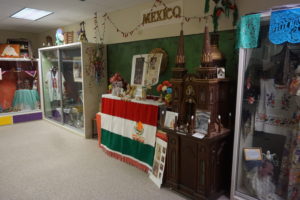
A large hall inside Pioneers Museum features galleries celebrating the ethnic groups who all played a part in founding Imperial County and today still remain part of the Imperial Valley community. Pictured here is the Mexican gallery.
Another of the key exhibits encased in glass is the original handwritten manuscript of The Winning of Barbara Worth, written by famed American author Harold Bell Wright, (1827-1944), who lived for a time in the Imperial Valley. The Winning of Barbara Worth is a fictionalized tale depicting the early days of the Imperial Valley and it concludes with the 1905 flood that formed the Salton Sea.
The Valley’s history is also told on the grounds outside the museum. Throughout the park there is a gathering of farm equipment used by the pioneers. There are historic buildings, including the Rose School House, one of the early school houses in the Valley, an old train depot, and even one of the first jails in the city of Holtville.
To spend time at the museum and park grounds is to journey back into history to better understand how pioneers found a way to not only survive in the harshest of environments but found a way through hard work and inventiveness to tap into the Colorado River, control its flows and grow bountiful harvests.
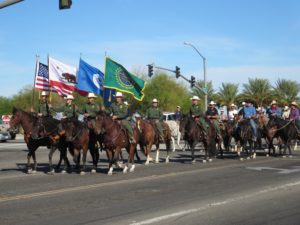
In November, some 50 horseback riders took part in the Ride of the Century event held by the museum to honor Imperial Valley pioneers. The riders started their journey by the East Highline Canal and finished at the museum. Photo courtesy of Pioneers Museum
“Our mission is to preserve what we can for our future generations to show them how we came to be here and how we survived,” Housouer said.
For Housouer, the museum has been her passion for the last 26 years. She was involved almost from the start of the building of the museum at its current location. She started as a volunteer in 1993 because she loved history and has led the museum (under different titles) since 1997.
“When I started here, we basically had a shell,” she said. “We had to go to work to fill that shell. So much was stored away in boxes, so I went to work digging through those boxes. In a lot of ways, it was like a treasure hunt.”
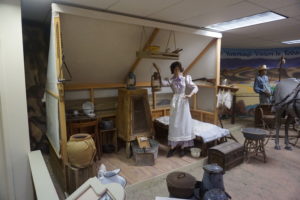
One of the museum’s goals is to show how the early pioneers survived in the desert’s harsh conditions. This display shows an example of a tent house erected by the early pioneers. Because it was a desert that lacked trees to build homes, the pioneers relied on these tent structures.
Housouer jokes that she has, in a very real sense, never stopped digging through boxes as there still are thousands of artifacts stored away. The work to catalogue them is a daily effort and one she enjoys the most.
“We are trying to preserve them the best we can,” she said. “And every day we are adding to our collection.”
Housouer credits the work of the historical society, the community volunteers and the individuals and businesses that donate both funding and supplies to the museum for helping her ensure Pioneers Museum continues to serve as a vital part of Valley’s future.
Pioneers Museum does not receive state or federal funding, she said. It survives thanks to a community that, much like the members of the first pioneers’ association, recognize the importance of sharing the Valley’s history with generations to come.
The museum also brings the community together through special events, most notably the annual Holiday Tour event held in December to showcase how the Valley’s different cultures celebrate the holiday season. Pioneers’ Day, set for Feb. 2 is another major community event, where the Valley’s history is brought to life through interactive displays throughout the park. The museum is open free to the public that day.
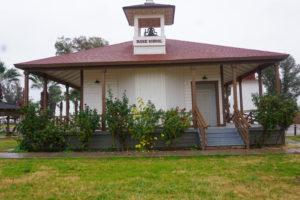
On the museum’s 22-acre grounds are a number of historic buildings and agricultural equipment and vehicles used by the pioneers. The Rose School House, pictured here, was one of the early schools built for the children of the pioneers.
In November 2018, the museum and historical society also held the Ride of the Century event in which horseback riders made their way through the Valley, from the East Highline Canal to the museum to honor how important horses were to the Valley’s pioneers. As part of that event, a time capsule of photos and letters from the event participants was put together to be opened in a hundred years for a future generation to see how people today honored the Valley’s history.
There are many other events the museum does throughout the year, including monthly Friday night lecture series where the Valley’s history is explored through presentations and discussions.
The museum is open Tuesday through Saturday from 10 a.m. to 4 p.m. and on Sundays, noon to 5 p.m.. Admission is $5 for children and $6 for adults.
“I hope visitors go away with an appreciation of what their ancestors went through to give them what they have today,” Housouer said. “It took everybody to make this county what it is today.”
